Things to do in Bangkok
Popular attractions in Bangkok showcase Thailand's fascinating history, despite Bangkok's relatively recent construction as a city. The most impressive of these is the enormous and extremely ornate Grand Palace, and the adjacent Temple of the Reclining Buddha. Numerous temples are situated in older districts near Chao Phraya River and make up an inexhaustible number of interesting visits, each one with a unique religious significance.
Attractions in Bangkok aren't all serene sights, though, as the city also holds a vibrant and flashy appeal. Among the most fun of attractions is watching a Muay Thai boxing fight; spectators can put some money down to increase the thrills. Bustling markets, which sell almost everything, can be wandered for a full day, especially the giant Chatuchak weekend market.
Bangkok's unique neighbourhoods encompass many small treasures. Khao San road in Banglamphu district and the alleys off of Sukhumvit are attractions in themselves. The first is a backpacker's Disneyland, and the second an expat playground famous for its debauchery. Little Arabia, a middle-eastern district, is another unique and fun place to explore. Hiring a river cruise is the only real tour of the city, although only a few attractions are visited.
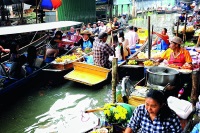
Damnoen Saduak Floating Market
The Damnoen Saduak Floating Market is an escape from the Western-style shopping malls of Bangkok and a glimpse into the past. Established in the 1860s, it features traditional wood…
Damnoen Saduak Floating Market
The Damnoen Saduak Floating Market is an escape from the Western-style shopping malls of Bangkok and a glimpse into the past. Established in the 1860s, it features traditional wooden boats loaded with fresh produce, souvenirs and Thai snacks as they navigate the canal system. Visitors can explore the market by boat and experience the bustling atmosphere as vendors interact with customers. The market is a popular tourist destination that offers a glimpse into Thai culture and history, though it's also a working market for locals. The lively setting, colourful boats and picturesque surroundings make it an unforgettable experience for travellers.
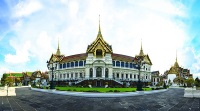
Royal Grand Palace
The Royal Grand Palace is a popular Bangkok attraction. Construction of the palace began in 1782 and was completed in time for the coronation of King Rama I, and opened in 1785 to …
Royal Grand Palace
The Royal Grand Palace is a popular Bangkok attraction. Construction of the palace began in 1782 and was completed in time for the coronation of King Rama I, and opened in 1785 to signify the end of the Burmese invasion of Thailand. The palace itself is made up of a complex array of smaller buildings, most notably the Wat Mahatat (the Palace Temple) and the Wat Phra Keow (the Royal Chapel), which houses the famous Emerald Buddha sculpted from a single piece of jade. It's one of the most revered objects in Thailand.
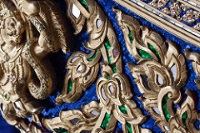
Royal Barges National Museum
The Royal Barges National Museum houses several decorative royal barges, the earliest of which dates back to 1357. Most of the barges served as war vessels at one point, and were s…
Royal Barges National Museum
The Royal Barges National Museum houses several decorative royal barges, the earliest of which dates back to 1357. Most of the barges served as war vessels at one point, and were subsequently used on royal or state occasions on the Chao Phraya River. Due to their age, the barges are now rarely used, but their intricate designs reflecting Thai religious beliefs and local history are of great importance to the country's heritage. The barges were last used at the end of 1999 to celebrate the king's 72nd birthday.
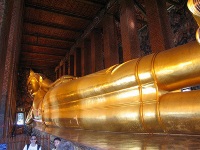
Temple of the Reclining Buddha (Wat Pho)
Situated adjacent to the Royal Grand Palace, Wat Pho is Bangkok's oldest, largest and most famous temple, and is recognised by the UNESCO Memory of the World Programme. The grounds…
Temple of the Reclining Buddha (Wat Pho)
Situated adjacent to the Royal Grand Palace, Wat Pho is Bangkok's oldest, largest and most famous temple, and is recognised by the UNESCO Memory of the World Programme. The grounds of Wat Pho contain over 1,000 statues of Buddha, and the temple houses one of Thailand's most spectacular sights, the Reclining Buddha: a 151-foot (46m) long and 49-foot (15m) high statue that is gold-plated and inlaid with Mother-of-Pearl on the soles of its feet. In the 19th century King Rama III turned Wat Pho into a centre of learning and it's considered the birthplace of the traditional Thai massage. Visitors today can still have a massage and learn about the ancient art of Thai Medicine.
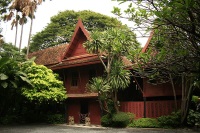
Jim Thompson’s House
American silk entrepreneur Jim Thompson deserves most of the credit for the current popularity of Thai silk around the world. Having travelled to Bangkok with the US Army in World …
Jim Thompson’s House
American silk entrepreneur Jim Thompson deserves most of the credit for the current popularity of Thai silk around the world. Having travelled to Bangkok with the US Army in World War II, Thompson was struck by the beauty of Thai silk and began marketing it to US buyers in 1948, establishing the Thai Silk Company Limited. His fame increased when, in 1967, Thompson disappeared in the Cameron Highlands of Malaysia under mysterious circumstances. He has never been heard of since. The house itself is an excellent example of Thai residential architecture, and inside is a display of his Oriental art and antique collection, as well as an array of his personal belongings.
Website www.jimthompsonhouse.com
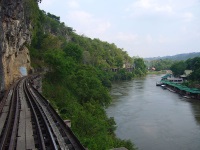
Kanchanaburi
Located 89 miles (143km) west of Bangkok, the town of Kanchanaburi is infamous as the original site of the Bridge Over The River Kwai, where during World War II Allied prisoners of…
Kanchanaburi
Located 89 miles (143km) west of Bangkok, the town of Kanchanaburi is infamous as the original site of the Bridge Over The River Kwai, where during World War II Allied prisoners of war were used by the Japanese to build the Death Railway, with thousands dying in the process. With its modern hotels and welcoming air, Kanchanaburi seems an unlikely setting, but the bridge is still in use and the graves of the Allied soldiers are testament to the town's unfortunate past. The JEATH (Japan, England, Australia, America, Thailand and Holland) War Museum in Kanchanaburi is worth a visit as it recounts experiences in the Japanese POW camps during the War. The Sai Yok Yai Waterfall in the Sai Yok National Park is a place of idyllic beauty and makes a good excursion from Kanchanaburi; the falls are widely celebrated in Thai poetry and songs. The turquoise waters of Erawan Falls are also reachable from Kanchanaburi, and make for an interesting day trip.
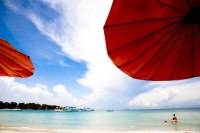
Koh Samet
The small, T-shaped island of Koh Samet is within easy distance of mainland Thailand and, at only 104 miles (168km) from Bangkok, makes for a great weekend excursion to get out of …
Koh Samet
The small, T-shaped island of Koh Samet is within easy distance of mainland Thailand and, at only 104 miles (168km) from Bangkok, makes for a great weekend excursion to get out of the city. Popular among foreigners and locals, Koh Samet is known for its white sandy beaches and crystal-clear waters. The destination has just one (rather bumpy) main road, and getting around the island is accomplished either by songthaew (a pick-up truck-style taxi), or by hiring a motorcycle or all-terrain vehicle. This way, tourists can visit the stunning beaches on Koh Samet, including the busy Hat Sai Kaew, quiet Ao Hin Khok, and romantic Ao Wai. Most of the activity is centred on Hat Sai Kaew, where holidaymakers can enjoy activities such as swimming, windsurfing, jet-skiing, yachting or just sunbathing. There are also nightly fire-twirling shows at 6pm and 10:30pm. Tourists can enjoy excellent Thai seafood restaurants and lively bars, and take classes in Muay Thai boxing or fire-spinning.
Website www.kosamet.net
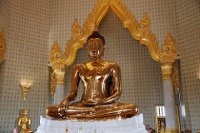
Temple of the Golden Buddha (Wat Traimit)
Dating back to the 13th century, the buddha at Wat Traimit stands nearly 10 feet (3m) tall, weighs over five tons and is believed to be solid cast gold. The largest gold statue in …
Temple of the Golden Buddha (Wat Traimit)
Dating back to the 13th century, the buddha at Wat Traimit stands nearly 10 feet (3m) tall, weighs over five tons and is believed to be solid cast gold. The largest gold statue in the world, it was discovered by accident in 1957 when an old stucco image was dropped by a crane, shattering the plaster shell to reveal the brilliantly shining gold underneath. The statue is breathtaking and is thought to have come from Ayutthaya covered in plaster to hide it from the Burmese invaders.
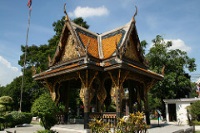
Bangkok National Museum
Originally built in 1874, the Bangkok National Museum is located within the grounds of the Royal Palace, just a 15-minute walk from the palace of the Emerald Buddha, and displays t…
Bangkok National Museum
Originally built in 1874, the Bangkok National Museum is located within the grounds of the Royal Palace, just a 15-minute walk from the palace of the Emerald Buddha, and displays thousands of artefacts ranging all the way from Neolithic times to present day. It's known as Thailand's central treasury of art and archaeology. Many of the actual buildings are works of art themselves, surrounded by brightly coloured pavilions and boasting some of Southeast Asia's most ornate jewellery and historical treasures. A visit to the museum is a must for anyone who wants a better understanding of Thailand's rich culture and history.
Website www.museumthailand.com/en/museum/National-Museum-Bangkok-Phranakorn
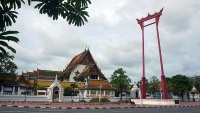
Wat Suthat and the Giant Swing
Wat Suthat is among the oldest and largest temples in Bangkok and is home to the beautiful 13th-century Phra Buddha Shakyamuni, a 25-foot (8m) tall bronze Buddha image that was bro…
Wat Suthat and the Giant Swing
Wat Suthat is among the oldest and largest temples in Bangkok and is home to the beautiful 13th-century Phra Buddha Shakyamuni, a 25-foot (8m) tall bronze Buddha image that was brought from Sukhothai and contains the ashes of King Rama VIII. It is also known for exquisite wall paintings that were done during the reign of Rama III. The enormous arch made of teak outside the wat is all that remains of an original swing that was used to celebrate and thank Shiva for a bountiful rice harvest. Teams of men would ride the swing on arcs as high as 82 feet (25m) into the air, grabbing at bags of silver coins with their teeth. The swing ceremony was discontinued in 1932 due to countless injuries and deaths, but the thanksgiving festival is still celebrated in mid-December after the rice harvest.
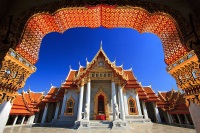
Wat Benchamabophit (The Marble Temple)
Wat Benchamabophit, also known as the Marble Temple, is constructed of white Carrara marble (even the courtyard is paved with polished white marble) and is known as one of Bangkok'…
Wat Benchamabophit (The Marble Temple)
Wat Benchamabophit, also known as the Marble Temple, is constructed of white Carrara marble (even the courtyard is paved with polished white marble) and is known as one of Bangkok's most beautiful temples. The temple's name literally means 'The Temple of the fifth King located nearby Dusit Palace'. Built of Italian marble and designed by Prince Naris, a half-brother of the king, it's unique in that, unlike older complexes, there's no wihaan or chedi dominating the grounds. The temple houses many Buddha images representing various regional styles. Inside the ornate Ordination Hall (Ubosot) is a Sukhothai-style Buddha statue named Phra Buddhajinaraja, and buried under this statue are the ashes of King Rama V. The site also contains the Benchamabophit National Museum.
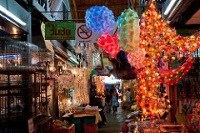
Chatuchak Market
The Chatuchak Market (also known as the JJ Market) is said to be the largest flea market in the world. 'Organised' along narrow grid lines under tin roofs, this enormous market is …
Chatuchak Market
The Chatuchak Market (also known as the JJ Market) is said to be the largest flea market in the world. 'Organised' along narrow grid lines under tin roofs, this enormous market is packed tight with all of Thailand's wares. Around 15,000 stalls are loosely categorised into clothing, crafts, food, and animal sections and it's easy to become disoriented. Some of Thailand's illegally traded animals are sold here and vendors are quick to spot signs of oncoming raids. However, a host of legal but bizarre goods are also traded; cock-fighting roosters, monkeys, fake designer gear and antiques are just the tip of the iceberg. The market is only open on the weekends from 8am to 6pm, and on Fridays for wholesalers. It's easily reached by the Skytrain from the Mo Chit station and by subway. Visitors should keep the import restrictions of their home countries in mind when shopping at Chatuchak Market, and buy accordingly.
Website www.chatuchakmarket.org/
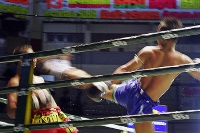
Muay Thai
Fight fans will get a kick out of Thailand's national sport, Muay Thai. The matches are best watched at the Rajadamnern stadium, though visitors should be warned that the prices fo…
Muay Thai
Fight fans will get a kick out of Thailand's national sport, Muay Thai. The matches are best watched at the Rajadamnern stadium, though visitors should be warned that the prices for foreigners or farang are much more than local's. Usually fewer than 10 matches are arranged for a night but the brutality of the style means that some of these result in quick knockouts. The events are a mix of traditional Thai music and traditional pre-match customs before the hard-hitting fight, in which competitors utilise elbows, knees, fists and shins to knock out the opponent. Several types of tickets are available, such as the more expensive fight-floor tickets, and tickets for the more rowdy informal gambling area on the second tier. Tourists should watch their hand movements, as they can be interpreted as willingness to bet. Fights can be seen on Mondays, Wednesdays, Thursdays, and Sundays in the evening. Lumpinee Stadium also showcases fights to a more touristy audience.
Website www.rajadamnern.com
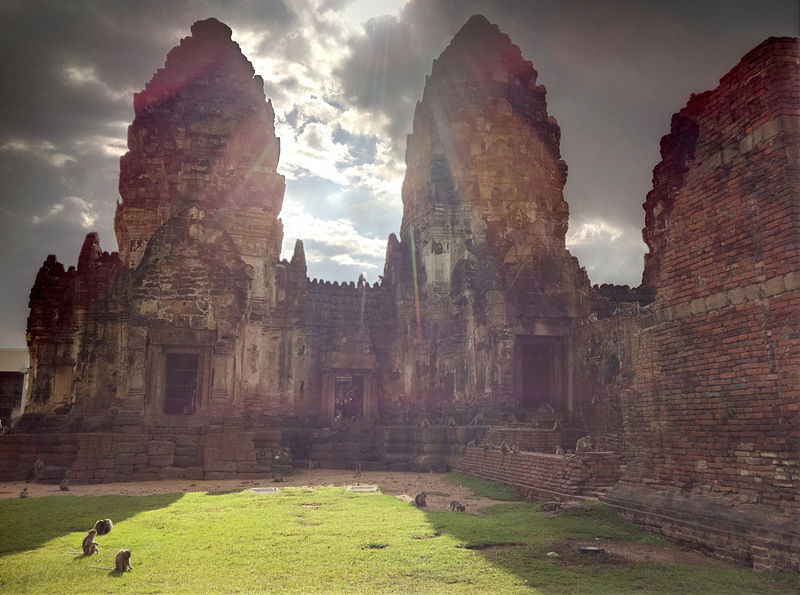
Lopburi Monkey Temple
The two and a half hour, 100-mile (150km) train ride to the Monkey Temple in the town of Lopburi is an easy day trip out of Bangkok. Legend has it the temple was founded by a falle…
Lopburi Monkey Temple
The two and a half hour, 100-mile (150km) train ride to the Monkey Temple in the town of Lopburi is an easy day trip out of Bangkok. Legend has it the temple was founded by a fallen arrow of Hanuman, the Hindu Monkey God. The animal kingdom hierarchy is reversed here, as the temple gives the monkeys free roam and food. Often novelty turns into nervousness as visitors are followed by crowds of the impolite inhabitants. Visitors can buy packs of sunflower seeds for THB 10 to feed the monkeys, but should keep watch of loose items such as glasses, purses, and especially food, as the monkeys are keen pickpockets and they bite. November is the Monkey Festival in Lopburi but it is interesting to visit year-round.
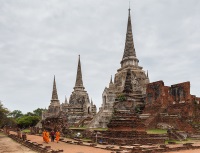
Ayutthaya
Ayutthaya was the capital of Siam from 1350 until mid-18th century, and at one time was one of the largest cities in the world. The capital was relocated to Bangkok in 1768, when t…
Ayutthaya
Ayutthaya was the capital of Siam from 1350 until mid-18th century, and at one time was one of the largest cities in the world. The capital was relocated to Bangkok in 1768, when the Burmese army destroyed much of Ayutthaya. Today, tourists don't need much imagination to experience the splendour of the old capital, as many of the enormous structures are still there, and the ruins of Ayutthaya have been designated a UNESCO World Heritage Site. Multiple buses (the trip takes a bit over an hour) and trains arrive daily from Bangkok, and a boat up the Chao Phraya River to Ayutthaya can be organised through travel agencies. Although many organised tours in Thailand can result in frustrating experiences, a tour guide in this instance can give some fascinating history to the already impressive wats. This is an easy way to experience some of the ancient history of Siam, as Bangkok is relatively new.

Children's Discovery Museum Bangkok
The Children's Discovery Museum Bangkok is a must-visit for families. Designed to spark curiosity and creativity, the museum offers hands-on exhibits where children can explore sci…
Children's Discovery Museum Bangkok
The Children's Discovery Museum Bangkok is a must-visit for families. Designed to spark curiosity and creativity, the museum offers hands-on exhibits where children can explore science, art, nature and technology in a fun, interactive environment. From imaginative play areas to engaging, educational workshops, it's a perfect spot for kids to learn through play. Parents can relax while their children embark on exciting adventures in a spacious, welcoming atmosphere, whether they're there on a rainy day or for a break from sightseeing. It's best to visit in the early morning or late afternoon to avoid large school groups.
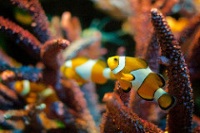
Sea Life Bangkok Ocean World
Located in the Siam Paragon Shopping Centre, Sea Life Bangkok Ocean World is one of the largest aquariums in Southeast Asia and features different zones that include tropical ocean…
Sea Life Bangkok Ocean World
Located in the Siam Paragon Shopping Centre, Sea Life Bangkok Ocean World is one of the largest aquariums in Southeast Asia and features different zones that include tropical ocean, coral reef and rocky beach. The aquarium features 30,000 marine animals, including Oriental Small-Clawed otters, ragged-tooth sharks, stingrays and giant groupers. Children will simply love Sea Life Bangkok Ocean World, as they can watch live shows, have a shark encounter, ride in a glass-bottom boat, or enjoy a 4D cinema experience.
Website www.visitsealife.com/bangkok/
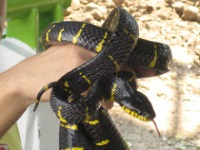
Snake Farm (Thai Red Cross Farm)
The Snake Farm is a unique attraction and educational centre dedicated to the study and conservation of snakes, particularly venomous species. Located near the Chao Phraya River, t…
Snake Farm (Thai Red Cross Farm)
The Snake Farm is a unique attraction and educational centre dedicated to the study and conservation of snakes, particularly venomous species. Located near the Chao Phraya River, the farm is part of the Thai Red Cross Society, and visitors can learn about various snakes, their venom and safety measures, with live demonstrations and venom extraction sessions held daily. The farm also plays a key role in producing antivenom for snakebites across Thailand. With over 30 species, including cobras and vipers, the Snake Farm offers an intriguing and educational experience for both locals and tourists.
Website red-social-innovation.com/en/solution/the-thai-red-cross-snake-farm/



